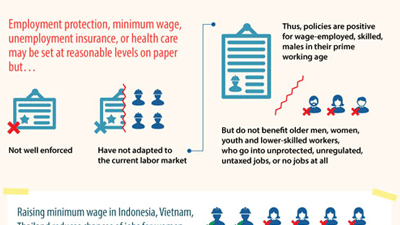Jakarta, INDONESIA, May 8, 2014 – A new World Bank report urges countries in East Asia Pacific to address the prevalence of the informal economy by enacting labor regulations and social protection policies that benefit people no matter where or how they work.
Modest, nationally-financed unemployment packages, for example, can help employers avoid costly severance schemes, lower labor taxes and encourage business to become formal, according to the report, East Asia Pacific at Work: Employment, Enterprise and Well-Being. Similarly, Thailand’s universal health care system has already lowered out-of-pocket costs for patients, led to wider user of medical services and reduced the risk of impoverishment caused by unexpected illnesses.
“Social protection policies should focus on protecting all working people, not favoring a particular sector, location or profession,” said Axel van Trotsenburg, World Bank East Asia and Pacific Regional Vice President. “When well designed, those policies will make sure that the most vulnerable workers have a pathway out of poverty and into middle-class prosperity.”
The report comes as policy makers are considering measures to formalize their labor markets after rapid economic development pushed labor participation rates in most East Asia Pacific countries to among the highest in the world. In the last 20 years, the region saw rising productivity amid a brisk structural transformation, with large movements of people into cities and higher output in agriculture, manufacturing and services. The share of the population working or seeking work in most East Asian countries, including women, is higher than other nations with similar income levels.
Despite fast economic growth in recent decades, the region’s growth rates are moderating and labor costs are rising. Further productivity gains are limited by skills gaps across the region and even a shortage of basic skills in Cambodia, Lao PDR and several Pacific island countries.
Meanwhile, the region’s prevailing labor market regulations and social protection policies are showing constraints. Designed when most workers were men in full-time, salaried employment, these policies today hurt the employment prospects of women, young people, and people with fewer skills, as well as those working part time or in self-employment.




